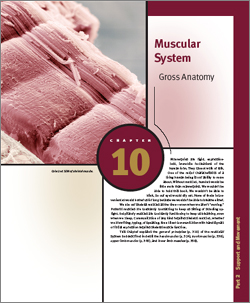
 | Mannequins are rigid, expressionless, immobile re-creations of the human form. They cannot walk or talk. One of the major characteristics of a living human being is our ability to move about. Without muscles, humans would be little more than mannequins. We wouldn't be able to hold this book. We wouldn't be able to blink, so our eyes would dry out. None of these inconveniences would bother us for long because we wouldn't be able to breathe either. We use our skeletal muscles all the time _ even when we aren't “moving.” Postural muscles are constantly contracting to keep us sitting or standing upright. Respiratory muscles are constantly functioning to keep us breathing, even when we sleep. Communication of any kind requires skeletal muscles, whether we are writing, typing, or speaking. Even silent communication with hand signals or facial expression requires skeletal muscle function. This chapter explains the general principles (p. 318) of the muscular system and describes in detail the head muscles (p. 324), trunk muscles (p. 338), upper limb muscles (p. 345), and lower limb muscles (p. 358). |